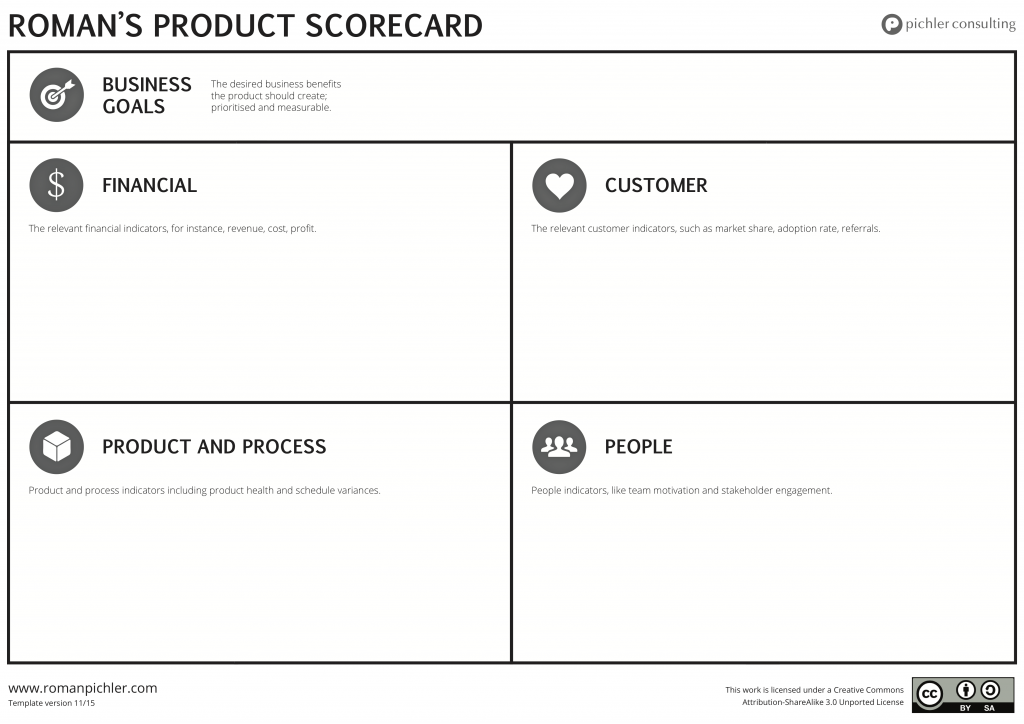A Balanced Product Scorecard
Summary
 Product scorecards are an important product management tool: They help you track the performance of your product. Unfortunately, many scorecards show only financial and customer key performance indicators (KPIs). While these indicators are undoubtedly important, ignoring other KPIs can create distorted view of reality and result in wrong decisions. This articles introduces a balanced product scorecard—a scorecard that provides a complete picture of the product performance thereby helping you to make the right product decisions.
Product scorecards are an important product management tool: They help you track the performance of your product. Unfortunately, many scorecards show only financial and customer key performance indicators (KPIs). While these indicators are undoubtedly important, ignoring other KPIs can create distorted view of reality and result in wrong decisions. This articles introduces a balanced product scorecard—a scorecard that provides a complete picture of the product performance thereby helping you to make the right product decisions.
Financial and Customer-Focused Scorecards
A product scorecard is similar to a car dashboard: Like the control panel displays speed, fuel consumption, and other vital information, a product scorecard shows the KPIs of your product—the metrics that measure how well your product is doing.
Most product managers I have worked with record only financial and customer KPIs on their scorecards. The former measure the financial performance of a product and include revenue, cost, profit, and customer lifetime value. Customer indicators focus on the customers and users; sample KPIs are market share, engagement, retention, and conversation rate. This focus has three common causes: Financial and customer KPIs are important to understand the product performance, senior management expects to see them, and they are easy to collect.
But a product scorecard that’s limited to these indicators is unbalanced—it can create a wrong view of how the product is performing. Say your product is meeting its revenue and profit goals and customer engagement and referral rate are also high. This seems to suggest that your product is doing well and that there is no reason to worry. If at the same time, team motivation and code quality are deteriorating, then you should be concerned, as this indicates that meeting the business goals and achieving success will be much more difficult in the future.
A Balanced Product Scorecard Template
The scorecard I have created and work with complements financial and customer indicators with product, process, and people KPIs. This mitigates the risk of overlooking important data and it provides a well-rounded, balanced view of the product performance. You can download the template, which is inspired by the work of Norton and Kaplan, from romanpichler.com/tools and by clicking on the image below.
The Five Sections of the Balanced Scorecard
The top section of the scorecard shown above states the business goals, which are the benefits your product should deliver, such as generating revenue, saving cost, helping sell another product or a service. Stating these goals communicates what the product performance is measured against.
Make sure that your business goals are measurable. While it is notoriously tricky to come up with correct targets for brand-new and young products, you should still try to quantify the goals so you can measure progress against them.
Below the business goals are four sections: financial, customer, product and process, and people. The first two capture the relevant financial and customer indicators—the metrics that help you measure the financial and customer-related performance of your product. Examples of the former are revenue, cost, profit; customer indicators include market share, conversion rate, and customer feedback.
The product and process section encourages you to track and display KPIs that tell you to how the product is being used and developed. Sample KPIs are user interaction like most/least used features, drop-off points, code quality like number of bugs and code complexity, schedule variances, such as the ability to meet goals on time and on budget, and open impediments or blockers.
The people section shows how engaged and supportive the development team members, the key stakeholders, and the management sponsor are. Relevant indicators include team motivation, sickness and turnover rate, development of the team knowledge and skills, and the level of stakeholder engagement and management support.
Product, Process, and People KPIs
It’s important that you capture product, process, and people indicators on a product scorecard, as they complement the financial and customer data: together, they provide you with a complete view of the product performance.
Additionally, most of them are leading indicators—they tell how likely it is to achieve success in the future. Take code quality as an example code. If the code quality is decreasing—more defects, higher code complexity—then it will be harder to meet the business goals in the future. But the majority of financial and customer indicators are lagging—they look at the outcome of past actions.
As mentioned before, considering only financial and customer data can create a false sense of security: you might assume that your product is doing well only to be surprised that team members are leaving, the number of bugs is increasing, or the development process is no longer working and release dates are difficult to meet.
Similarly, if the development team works flat out and has no time to investigate new tools and technology, then knowledge and skills in the team is not improving. This may make it difficult to respond to new trends and leverage new technologies—in addition to the risk that the team members are becoming demotivated and possibly starting to cut quality.
The Rule of Three
Using additional indicators means that you have to spend more effort collecting and analysing the appropriate data. It’s therefore important that as a rule of thumb, you limit yourself to three indicators per section. Choose only those indicators that are relevant and help you measure the performance of the product against it business goals. Discard the rest—even if your analytics tool offers them for free. Working with too many indicators is confusing and makes it difficult to see how the product is performing.
| Reference: | A Balanced Product Scorecard from our JCG partner Roman Pichler at the Pichler’s blog blog. |





